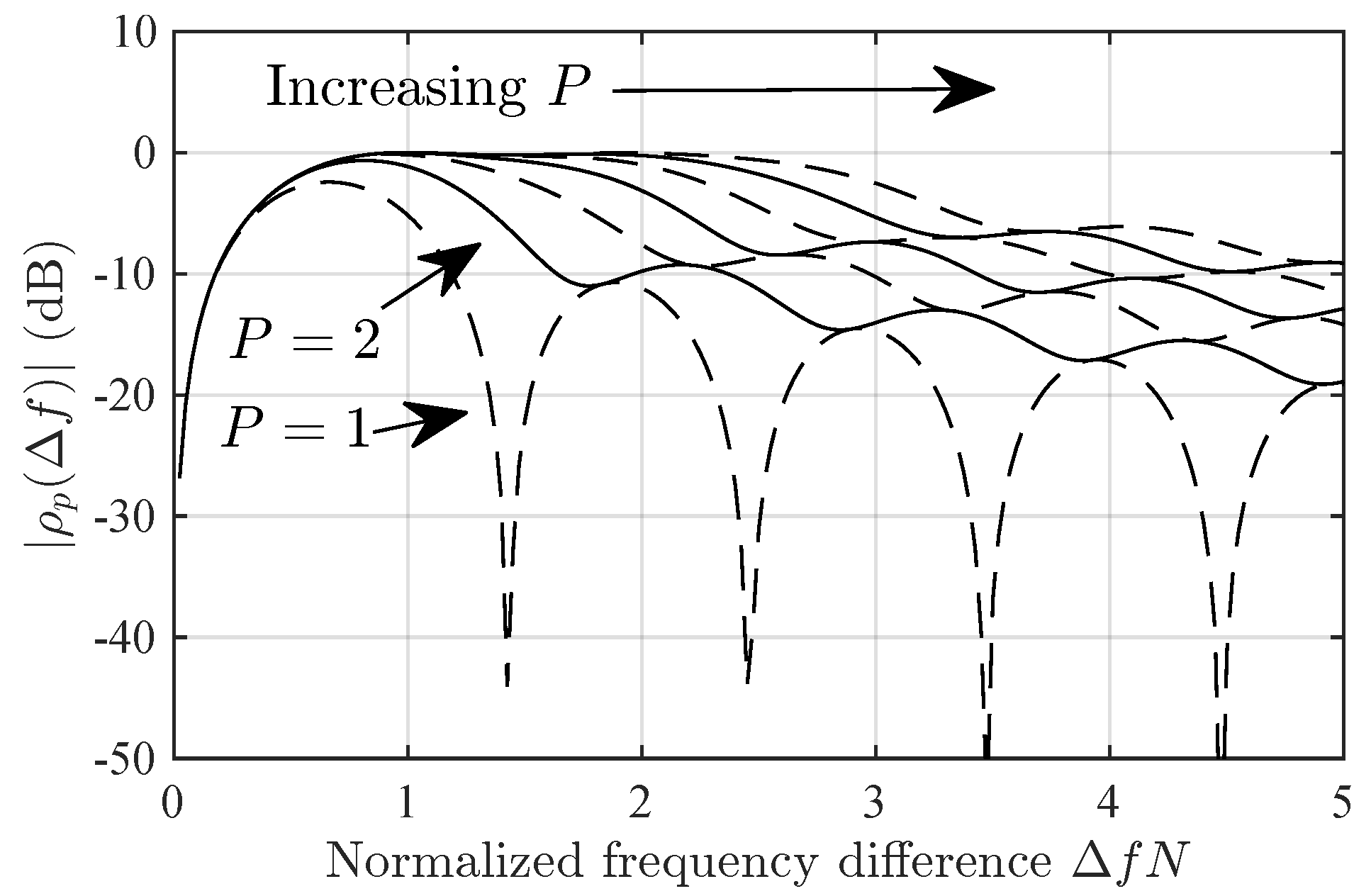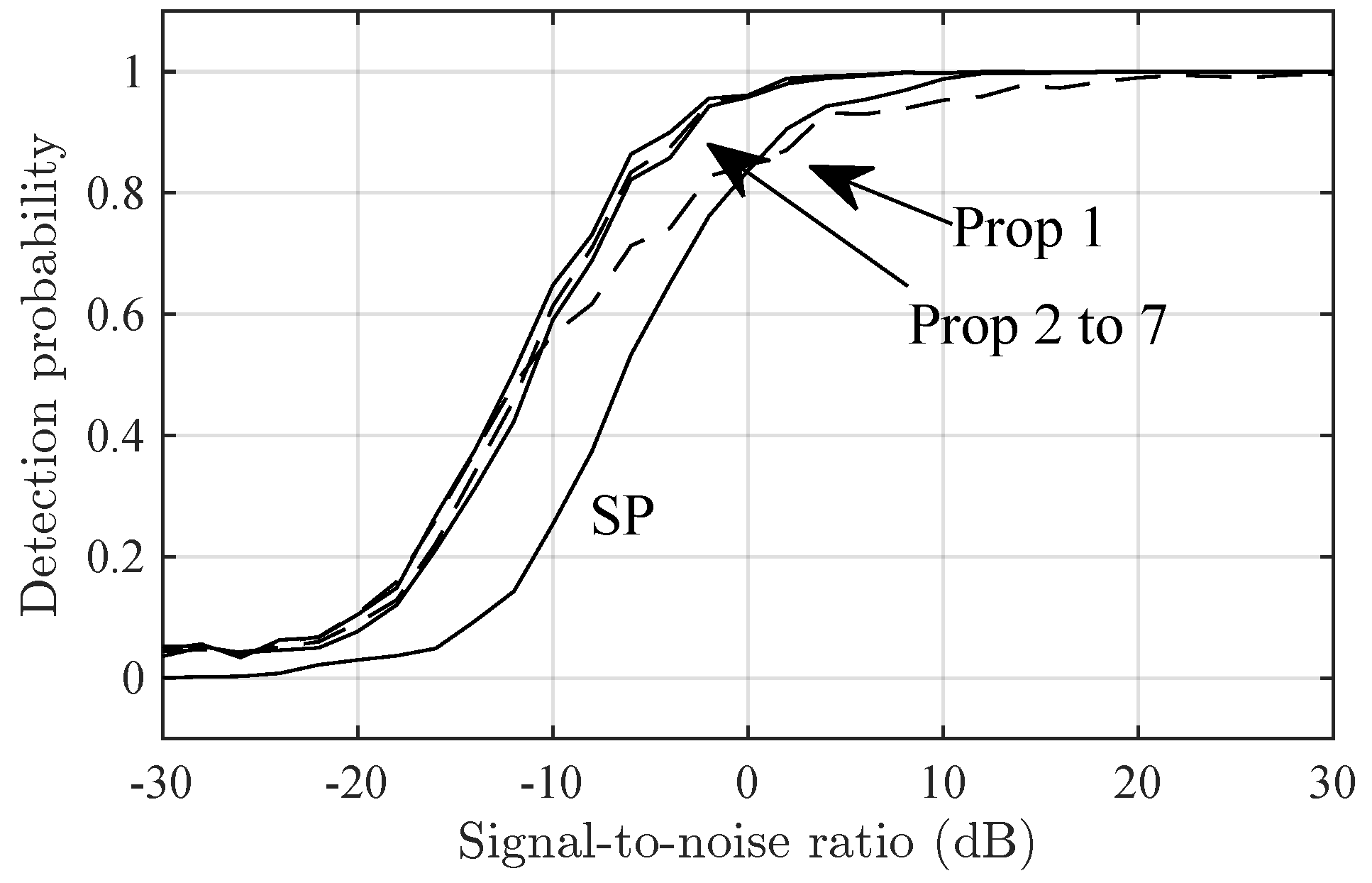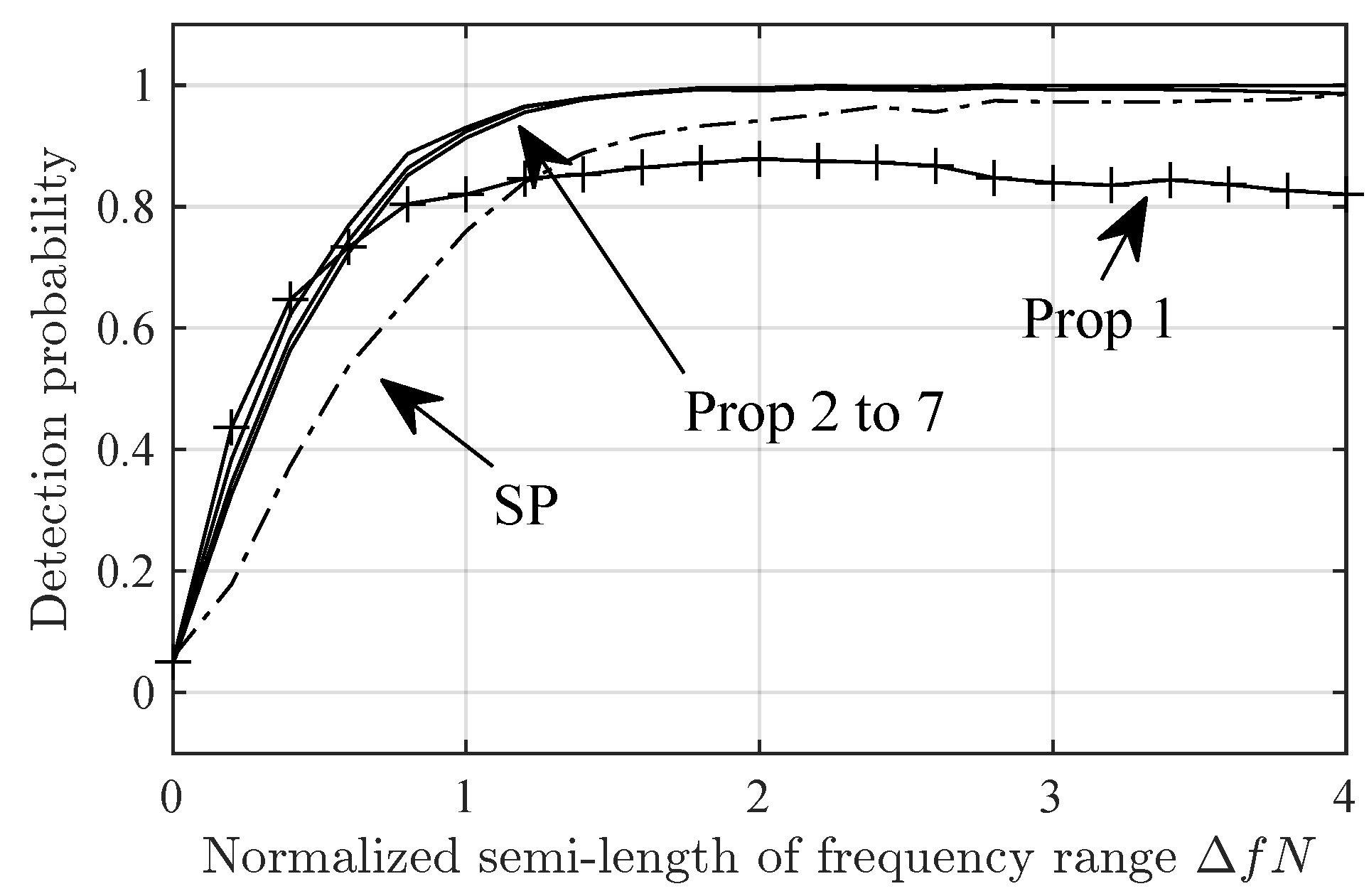Detection and Estimation of Diffuse Signal Components Using the Periodogram
Abstract
1. Introduction
Notation
- We denote column vectors in bold and lower case (, ).
- denotes the identity matrix.
- denotes the nth component of vector .
- and are the transpose and Hermitian of vector , respectively.
- New symbols or functions are introduced using the symbol “≡”.
- is the discrete Dirac delta, i.e., and for integer .
- denotes a column vector of zeroes whose length can be determined from the context.
- For a function , denotes the total derivative of at the value , i.e., is the best linear approximation to at .
2. Signal Models for a Pure and a Diffuse Component: Sketch of the Proposed Method
- ; , .
- has the same span as for , P.
3. Gram–Schmidt Basis of the Span of the Signature and Its Derivatives
3.1. Definition of the Gram–Schmidt Basis in Terms of Discrete Chebyshev Polynomials
3.2. Three-Term Relationship for Basis Signature Derivatives
3.3. Selection of a Frequency Range Using Basis Signatures
4. Statistical Distribution of Correlations with Ortho-Normal Signatures
- is a real Gaussian variable of mean and variance
- The correlations , , are statistically independent.
- is a real Gaussian variable of zero mean and variance .
- , , is a complex circularly symmetric Gaussian variable of zero mean and variance .
5. Detection of a Diffuse Component: Spread Factor
6. Computation of Correlations from DFT Samples
7. Numerical Assessment
- Type 1. Scenario with two frequency components of unequal power. Its distribution in (5) iswhere and .
- Type 2. Scenario with main frequency and a diffuse component. Its distribution iswhere the summation models the diffuse component and lie in a range , .
- Delta. Type-1 scenario with , , and uniformly distributed in .
- Delta-. The same as Delta, but viewing the phase of relative to as a variable .
- Delta-. The same as Delta, but with variable .
- Diffuse. Type-2 scenario with and amplitudes, phases, and frequencies in summation following uniform distributions in , , and , respectively.
- Diffuse-. The same as Diffuse, but with variable .
- Secondary peak (SP). The second signal component is detected if the residual periodogram given byhas a peak above a detection threshold with false-alarm probability.
- Proposed (Prop-). The detector in Section 5 with a given truncation order P and 0.05 false-alarm probability.
7.1. Performance Versus Signal-to-Noise Ratio
7.2. Detection Performance Versus Frequency Spread
7.3. Spread Factor
8. Conclusions
Funding
Institutional Review Board Statement
Informed Consent Statement
Data Availability Statement
Conflicts of Interest
Appendix A. Proof of (29)
Appendix B. Perturbation Analysis of the Periodogram Estimator
- , and denote , and , respectively.
- stands for .
- The subscript “y” stands for the derivative in y.
- Subscript “0” denotes evaluation at ; for example is the derivative in y of at .
Appendix B.1. Total Derivative of Periodogram Estimate (ϵ)
Appendix B.2. Total Derivatives of Correlations (ϵ)
References
- Percival, D.B.; Walden, A.T. Spectral Analysis for Univariate Time Series; Cambridge University Press: Cambridge, UK, 2020; Volume 51. [Google Scholar]
- Kay, S.M. Modern Spectral Estimation, 1st ed.; Signal Processing; Prentice Hall: Hoboken, NJ, USA, 1988. [Google Scholar]
- Rife, D.; Boorstyn, R. Single tone parameter estimation from discrete-time observations. IEEE Trans. Inf. Theory 1974, 20, 591–598. [Google Scholar] [CrossRef]
- Rife, D.C.; Boorstyn, R.R. Multiple tone parameter estimation from discrete-time observations. Bell Syst. Tech. J. 1976, 55, 1389–1410. [Google Scholar] [CrossRef]
- Selva, J. Interpolation of bounded band-limited signals and applications. IEEE Trans. Signal Process. 2006, 54, 4244–4260. [Google Scholar] [CrossRef]
- Selva, J. An efficient Newton-type method for the computation of ML estimators in a Uniform Linear Array. IEEE Trans. Signal Process. 2005, 53, 2036–2045. [Google Scholar] [CrossRef]
- Molisch, A.F.; Tufvesson, F.; Karedal, J.; Mecklenbrauker, C.F. A survey on vehicle-to-vehicle propagation channels. IEEE Wirel. Commun. 2009, 16, 12–22. [Google Scholar] [CrossRef]
- Richter, A. Estimation of Radio Channel Parameters: Models and Algorithms. Ph.D. Thesis, Faculty for Electrical Engineering and Information Technology, University of Ilmenau, Ilmenau, Germany, 2005. [Google Scholar]
- Quinn, B.G. Estimating Frequency by Interpolation Using Fourier Coefficients. IEEE Trans. Signal Process. 1994, 42, 1264–1268. [Google Scholar] [CrossRef]
- Mcleod, M. Fast Nearly ML Estimation of the Parameters of Real or Complex Single Tones or Resolved Multiple Tones. IEEE Trans. Signal Process. 1998, 46, 141–148. [Google Scholar] [CrossRef]
- Aboutanios, E.; Mulgrew, B. Iterative Frequency Estimation by Interpolation on Fourier Coefficients. IEEE Trans. Signal Process. 2005, 53, 1237–1242. [Google Scholar] [CrossRef]
- Selva, J. Efficient maximum likelihood estimation of a 2-D complex sinusoidal based on barycentric interpolation. In Proceedings of the International Conference on Acoustics Speech, and Signal Processing, Prague, Czech Republic, 22–27 May 2011; pp. 4212–4215. [Google Scholar]
- Candan, C. A method for fine resolution frequency estimation from three DFT samples. IEEE Signal Process. Lett. 2011, 18, 351–354. [Google Scholar] [CrossRef]
- Orguner, U.; Candan, Ç. A fine-resolution frequency estimator using an arbitrary number of DFT coefficients. Signal Process. 2014, 105, 17–21. [Google Scholar] [CrossRef]
- Selva, J. ML Estimation and Detection of Multiple Frequencies Through Periodogram Estimate Refinement. IEEE Signal Process. Lett. 2017, 24, 249–253. [Google Scholar] [CrossRef]
- Serbes, A. Fast and Efficient Estimation of Frequencies. IEEE Trans. Commun. 2021, 69, 4054–4066. [Google Scholar] [CrossRef]
- D’Amico, A.A.; Morelli, M.; Moretti, M. Frequency estimation by interpolation of two Fourier coefficients: Cramér-Rao bound and maximum likelihood solution. IEEE Trans. Commun. 2022, 70, 6819–6831. [Google Scholar] [CrossRef]
- Selva, J. Design of Barycentric Interpolators for Uniform and Nonuniform Sampling Grids. IEEE Trans. Signal Process. 2010, 58, 1618–1627. [Google Scholar] [CrossRef]
- Fleury, B. First- and second-order characterization of direction dispersion and space selectivity in the radio channel. IEEE Trans. Inf. Theory 2000, 46, 2027–2044. [Google Scholar] [CrossRef]
- Akdeniz, M.R.; Liu, Y.; Samimi, M.K.; Sun, S.; Rangan, S.; Rappaport, T.S.; Erkip, E. Millimeter Wave Channel Modeling and Cellular Capacity Evaluation. IEEE J. Sel. Areas Commun. 2014, 32, 1164–1179. [Google Scholar] [CrossRef]
- Wang, Q.; Yuan, X.; Xu, C.; Wang, X. A Bayesian Approach to Communication-Driven SLAM Based on Diffuse Reflection Model. IEEE Wirel. Commun. Lett. 2023, 12, 1279–1283. [Google Scholar] [CrossRef]
- Wen, F.; Wymeersch, H. 5G Synchronization, Positioning, and Mapping From Diffuse Multipath. IEEE Wirel. Commun. Lett. 2021, 10, 43–47. [Google Scholar] [CrossRef]
- Szego, G. Orthogonal Polynomials; American Mathematical Society: Providence, RI, USA, 1939; Volume 23. [Google Scholar]
- Hirvensalo, M. Studies on Boolean Functions Related to Quantum Computing; Citeseer: Philadelphia, PA, USA, 2003. [Google Scholar]
- Knab, J.J. Interpolation of band-limited functions using the Approximate Prolate series. IEEE Trans. Inf. Theory 1979, IT-25, 717–720. [Google Scholar] [CrossRef]







Disclaimer/Publisher’s Note: The statements, opinions and data contained in all publications are solely those of the individual author(s) and contributor(s) and not of MDPI and/or the editor(s). MDPI and/or the editor(s) disclaim responsibility for any injury to people or property resulting from any ideas, methods, instructions or products referred to in the content. |
© 2024 by the author. Licensee MDPI, Basel, Switzerland. This article is an open access article distributed under the terms and conditions of the Creative Commons Attribution (CC BY) license (https://creativecommons.org/licenses/by/4.0/).
Share and Cite
Selva, J. Detection and Estimation of Diffuse Signal Components Using the Periodogram. Sensors 2024, 24, 6650. https://doi.org/10.3390/s24206650
Selva J. Detection and Estimation of Diffuse Signal Components Using the Periodogram. Sensors. 2024; 24(20):6650. https://doi.org/10.3390/s24206650
Chicago/Turabian StyleSelva, Jesus. 2024. "Detection and Estimation of Diffuse Signal Components Using the Periodogram" Sensors 24, no. 20: 6650. https://doi.org/10.3390/s24206650
APA StyleSelva, J. (2024). Detection and Estimation of Diffuse Signal Components Using the Periodogram. Sensors, 24(20), 6650. https://doi.org/10.3390/s24206650





